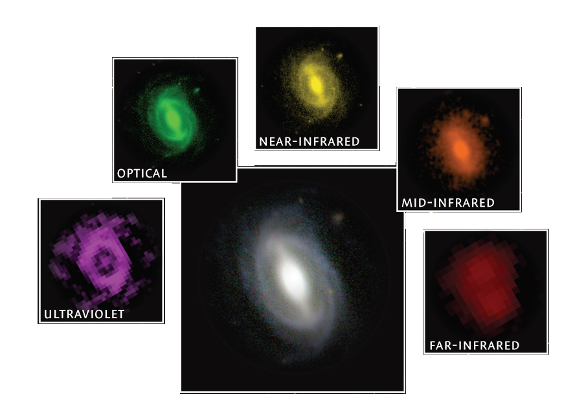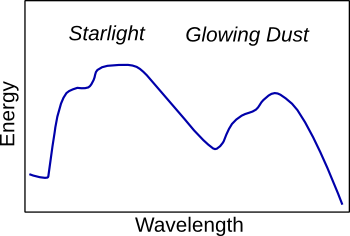The Big Freeze
September 10, 2015
The
Robert Frost poem,
Fire and Ice,[1] has the opening lines, "Some people say the world will end in
fire, Some say in
ice." As
referenced in Wikipedia,
astronomer Harlow Shapley (1885-1972) thought that he had inspired this poem. A year before the poem was published, Frost asked Shapley how the world would end. Shapley said that the
Sun would either die out ("ice"), or it would
explode ("fire").

Fire & Ice.
Sunset at Woodbine Beach, Toronto, Canada, after a rainstorm.
(Photo by Benson Kua, via Wikimedia Commons.)
Whether the
universe, itself, has its own fire-or-ice
end point was a question debated in the early part of the
20th century. After
universal expansion was discovered, some
cosmologies claimed that the universe would continue to expand ("ice"), while others thought that the expansion would eventually reverse itself, leading to what's poetically described as the
Big Crunch ("fire").
The Big Crunch would be followed by another
Big Bang, and the universe would be reborn. This is the cosmology in the
Futurama episode,
The Late Philip J. Fry (Season 6, episode 7). In that episode, the
evolution of the reborn universe is precisely the same as the old one, within a ten
foot error. Recent
observations indicate that the universal expansion is accelerating, so it looks as if we are headed towards a
Big Freeze.
A huge international team of nearly a hundred astronomers from 33 institutions has just published a thorough analysis of how fast the universe is winding down.[2-5] The team was led by
Simon P. Driver, a
professor of
astrophysics at the
University of St. Andrews School of Physics & Astronomy. They precisely measured the
energy generation of more than 200,000
galaxies to create a comprehensive assessment of the energy output of the universe in our region of
space. They found that the energy production of these galaxies has declined by 50% in the past two billion years.
This study was part of the
Galaxy And Mass Assembly (GAMA) project using many of the world's
telescopes to survey galaxies at many
wavelengths.[3-4] Says Prof. Driver, who presented the team's findings from
far ultraviolet to
far infrared at the
International Astronomical Union XXIX General Assembly (Honolulu, Hawaii, August 10, 2015),
"We used as many space and ground-based telescopes as we could get our hands on to measure the energy output of over 200,000 galaxies across as broad a wavelength range as possible."[3-4]
The current
dataset, which includes measurements of the energy output of each galaxy at 21 wavelengths, was obtained by the following ground-based and
space telescopes (in order of increasing wavelength):
GALEX,
SDSS,
VST,
AAT,
VISTA,
UKIRT,
WISE, and
Herschel.[3-4]

A galaxy from the Galaxy And Mass Assembly (GAMA) project observed at different wavelengths from the far ultraviolet to the far infrared. (Simplified ICRAR / GAMA image.)
The two principal sources of energy in the universe are the
nuclear fusion in
stars, and the
gravitational energy from the infall of
matter near the
black holes at
galactic centers. The black holes create hot discs of matter around the
galactic nuclei. Dust clouds create longer wavelength radiation by absorbing and
re-radiating energy.[3-4] The object of the GAMA study is the mapping and
modeling of all of these energy sources in a large
volume of space representative of
present and past times.[3-4]

Typical energy spectrum of a galaxy from the far ultraviolet (left) to the far infrared (right).
(Source data: ICRAR / GAMA image.)
As Driver explains,
"While most of the energy sloshing around in the Universe arose in the aftermath of the Big Bang, additional energy is constantly being generated by stars as they fuse elements like hydrogen and helium together... This new energy is either absorbed by dust as it travels through the host galaxy, or escapes into intergalactic space and travels until it hits something, such as another star, a planet, or, very occasionally, a telescope mirror."[3-5]
It's been known since the late
1990s that the universe is winding down, but the GAMA survey is the first attempt to detail the decline. The data, says Driver, show that "the universe has basically sat down on the
sofa, pulled up a
blanket and is about to nod off for an eternal
doze."[3-5]
GAMA's future plan is to add the
radio spectrum to its survey, getting data from other observatories, including the
Square Kilometre Array (SKA). The SKA will be the world's largest
radio telescope once it's built in
Australia and
South Africa.[3-4] A "fly-through" of objects in the GAMA survey is available at ref. 6.[6]

A galaxy from the GAMA survey observed at different wavelengths by different telescopes. (Portions of an ICRAR / GAMA image.)
References:
- Robert Frost, "Fire and Ice," Harper's Magazine, vol. 142, p. 67 (Via Google Books).
- Simon P. Driver, et al., "Galaxy And Mass Assembly (GAMA): Panchromatic Data Release (far-UV|far-IR) and the low-z energy budget." Monthly Notices of the Royal Astronomical Society (To Appear). Also at http://www.simondriver.org/mwavev02.pdf.
- Charting the Slow Death of the Universe - GAMA survey releases first data at IAU General Assembly, European Space Agency Press Release eso1533, August 10, 2015.
- Charting the Slow Death of the Universe - GAMA survey releases first data at IAU XXIX General Assembly, International Astronomical Union Press Release iau1509, August 10, 2015.
- Scientists measure Slow Death of the Universe, International Centre for Radio Astronomy Research (ICRAR) Press Release, August 11, 2015
- A fly-through of objects in the GAMA survey by Will Parr, Dr. Mark Swinbank and Dr. Peder Norberg (Durham University) using data from the SDSS and the GAMA surveys. Music composed and created by Holly Broadbent.
Permanent Link to this article
Linked Keywords: Robert Frost; poem; Fire and Ice; fire; ice; Wikipedia; astronomer; Harlow Shapley (1885-1972); Sun; supernova; explosion; sunset; Woodbine Beach; Toronto, Canada; rainstorm; Benson Kua; Wikimedia Commons; universe; ultimate fate of the universe; end point; 20th century; metric expansion of space; universal expansion; physical cosmology; cosmologies; Big Crunch; Big Bang; Futurama; The Late Philip J. Fry; evolution; foot; accuracy and precision; error; astronomy; observation; heat death of the universe; Big Freeze; Simon P. Driver; professor; astrophysics; University of St. Andrews; School of Physics & Astronomy; energy; galaxy; galaxies; outer space; Galaxy And Mass Assembly (GAMA) project; telescope; wavelength; far ultraviolet; far infrared; International Astronomical Union XXIX General Assembly (Honolulu, Hawaii, August 10, 2015); dataset; space observatory; space telescope; GALEX; SDSS; VST; AAT; VISTA; UKIRT; WISE; Herschel; nuclear fusion; star; gravitational energy; matter; black hole; galactic center; active galactic nucleus; cosmic dust; dust cloud; electromagnetic radiation; re-radiating; mathematical model; modeling; volume; deep time; present and past times; energy spectrum; chemical element; hydrogen; helium; intergalactic space; planet; reflecting telescope; telescope mirror; 1990s; couch; sofa; blanket; sleep; doze; radio spectrum; Square Kilometre Array; radio telescope; Australia; South Africa.